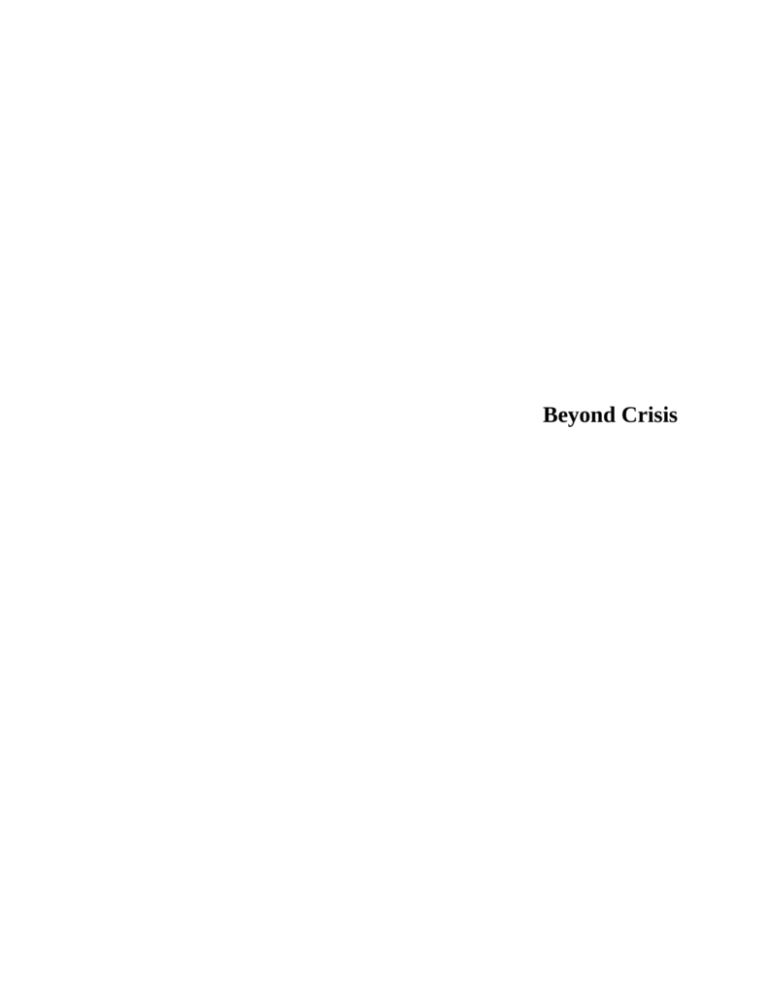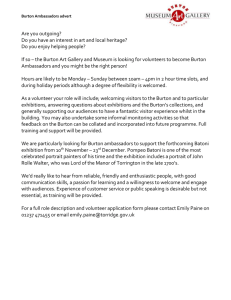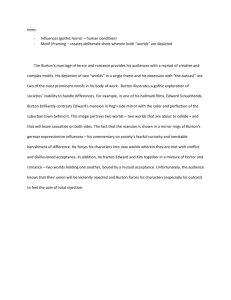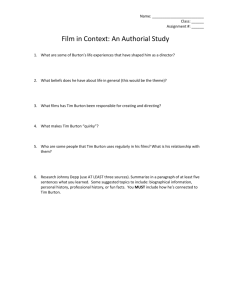Beyond Crisis - Diamond Management Consulting Inc.
advertisement

Beyond Crisis Beyond Crisis Page 2 Beyond Crisis: addressing deep-rooted conflict through creative understanding of climate, human needs and cultural variation Creating a Constructive Climate For a successful outcome, one of the first considerations is the effect of climate on the conflict interaction. Specifically, the goal is to create a constructive climate conducive to optimal communication. After Gibb (1961), I shall distinguish between defensive and supportive climates. While there may be no “ideal” climate in anything so complex as the interaction in a conflict, there are definite and tangible steps that can be taken to maximize the possibilities of a supportive climate. In a defensive climate, the parties perceive or anticipate threats. Thus, the energy is focused on self-protection and defeating the other party. Such an outlook can both distort one’s perceptions (e.g. not hear the messages of the other party) and project an image of defensiveness. Thus, a vicious cycle is set up, where defensiveness breeds defensiveness. The opposite is a supportive climate, in which communication is accurately stated and received, and behaviour that is supportive of a productive outcome is reinforced. To illuminate these contrasting positions, Gibb lists six opposing categories: Defensive evaluative communication Supportive descriptive communication (judgements, criticisms) controlling communication (‘I’ statements, “I feel, I see...”) problem-oriented communication (attempts to control, fosters resistance) use of statements that appear strategic (locates the issue in a problem, not a person) statements appear spontaneous, unguarded (projects hidden motivations) flat, apathetic speech (projects ‘what you see is what you get’) empathetic speech style (shows ‘I don’t care about you/this situation’) speech style of superiority, power (shows respect/care about other party) speech style recognizes common ground (received defensively, message not heard) dogmatic messages of ‘certainty’ (shared, collaborative, problem-solving) flexible, willing-to-listen messages (‘know it all’ attitude engenders resistance) (shows openness to options) Human Needs and Analytical Problem Solving Analytical problem solving is a social-psychological approach to dealing with deep-rooted, protracted intergroup conflicts. Initially developed by John W. Burton (1993, 1997), this Diamond Management Consulting Inc. This material is copyrighted. Do not use in whole or in part without written permission of Diamond Management Consulting Inc. Beyond Crisis Page 3 technique is based on the human needs theory of conflict—most deep-rooted conflicts are caused by one or more groups’ inability to obtain its fundamental human needs—e.g. identity, security, or recognition. By identifying the underlying needs that are lacking, parties are often able to redefine the conflict in a way that facilitates joint problem solving and collaboration, a mutual recognition that begins to shift the ‘us versus them’ to ‘we.’ It is in the recognition of, and the sense of, identity that people are able to comprehend the others’ needs. As Burton’s colleague E.E. Azar eloquently expresses it: "We are led to the hypothesis that the source of protracted social conflict is the denial of those elements required in the development of all people and societies, and whose pursuit is a compelling need in all. These are security, distinctive identity, social recognition of identity, and effective participation in the processes that determine conditions of security and identity, and other such developmental requirements. The real source of conflict is the denial of those human needs that are common to all and whose pursuit is an ontological drive in all." (Azar, 1985, p. 60) Burton emphasizes the utter importance that group identity has for its members by noting that “Members of ethnic communities will slaughter others and sacrifice themselves in the preservation of ethnic identity and of the personal recognition and security it provides.” (Burton, 1997) Traditionally, says Burton, behavioural scientists have concluded in the end that individuals must conform to legal norms of the larger society, a conclusion which must assume that individuals are entirely malleable and conforming, and have a capacity to adjust to institutional requirements. What has been missing, due to these unexamined assumptions, is any consideration of the possibility of individuals having “...inherent needs requiring institutions to adjust to the person [emphases added].” Burton points out that this is what is at work in the many situations seen in recent history, where police have been unable to enforce law and order (e.g. Oka crisis) and great powers have been defeated by small nations (e.g. Vietnam war) (Burton, 1997). Diamond Management Consulting Inc. This material is copyrighted. Do not use in whole or in part without written permission of Diamond Management Consulting Inc. Beyond Crisis Page 4 The shift in thinking that has come from these understandings, from the application of Conflict Analysis and Resolution principles, is: a decision-making process which avoids the necessity to rest on power or enforcement by getting to the source of problems and resolving them to the satisfaction of all parties. The empirical evidence is that this is realistic and practical, for once parties to a conflict have been able to define it in basic terms of shared human needs, there can be a realistic costing of options and a practical exploration of means by which all concerned can ensure their satisfaction. (Burton 1997) For a society to have the means of dealing with these conflicts, Burton argues that conflict resolution must penetrate the customary ways the political system deals with conflict via a shift in political philosophy to embrace “... [alternate] conflict resolution processes and conflict prevention policies [as] the means for peaceful change.” (Burton, 1993, p. 63) Burton coins the term “provention” to convey this attitude, a policy that moves away from coercive strategies of enforcement from a power-based “realism” towards an approach that is centered on a functional/needs-based understanding of the relationship between the persons in conflict and the problem that lies between them and an examination of the possible options (pp. 63-64). As shown in the above analysis, ethnic conflicts are of a kind that resists traditional “realist” forms of mediation and negotiation. Even where a psychologically sensitive approach that recognizes the emotional needs of the aggrieved group is used, it may not completely succeed in bringing about the sought-for resolution of conflict. This is so due to the accumulation of historical grievances. Conflict resolution practitioner and theorist Joseph Montville points out that the group sense of historical grievances over losses of life and territory leave the members with a painful sensitivity to issues of safety and justice embodied in a collective sense of victim hood. Montville describes the genesis of victim hood in the experiences of historic violent and traumatic aggression and loss, a conviction that the aggression was unjustified by any standard, and the (often silent) belief that the aggressor will strike again (Montville, 1993, pp. 112 - 113). Montville writes of a healing process that needs to take place; one facilitated between conflicting Diamond Management Consulting Inc. This material is copyrighted. Do not use in whole or in part without written permission of Diamond Management Consulting Inc. Beyond Crisis Page 5 groups by a mediator who strives to bring about a shift in the antagonistic value systems and negative beliefs about the other among the adversaries. This is accomplished by bringing out new information about each of the parties, which contradicts the unrealistic stereotypes, replacing them with perceptions based upon new and more accurate information about each other (p. 114). Montville recommends the convening of a problem-solving workshop with groups of delegates from each side. The goal is to make possible a process of undermining negative stereotypes and replacing these with perceptions that allow a re-humanized relationship. One of the first steps in this process is the ‘confirming’ of each party of the other’s fundamental values and intrinsic human worth. Once having affirmed the significance of the other, the ground has been prepared for the next layer in building a working relationship, that of trust (pp. 114 - 115). The taking of a history of the conflict is another important element; it is necessary to examine both the historical elements of the grievances and resulting sense of victim hood as well as the justifications used by the aggressor to describe their view of the history of the conflict. Both perspectives, victim hood and justification, are psychological devices that preserve constancy of outlook, but which need to be dismantled for there to be progress (pp. 115 - 116). Once some trust has been established, and negative stereotypes, victimizations and justifications have been lessened, the stage is set for a process of communication and mutual understanding that involves acceptance of responsibility, contrition and forgiveness. By hearing an adversary’s grievances, acknowledging the effects of one’s group’s actions, expressing regret for the harm caused on the part of the aggressor, and allowing for a reciprocal expression of forgiveness from the transgressed party, a powerful and cathartic healing effect on the entrenched emotions fuelling the conflict can be achieved (pp. 117 - 119). It is important to note, however, that a simple act of declaring regret or forgiveness is not sufficient to bring about a genuine healing transaction. The genuineness of the exchange, based upon trust and a reconstructed view of one another, is essential (pp. 120 - 121). In addition, expressions of contrition and reciprocal acknowledgements in the form of forgiveness need to reach the larger public represented by the delegates, through open declaration of the understandings and the details upon which they are Diamond Management Consulting Inc. This material is copyrighted. Do not use in whole or in part without written permission of Diamond Management Consulting Inc. Beyond Crisis Page 6 based. In this way, the correction of distorted stereotypes begins to take place in the larger group itself, thus laying the groundwork for greater permanence of whatever understanding and accord is reached (pp. 123 - 125). References Azar, E. (1985) “Protracted international conflicts: ten propositions.” in International Interactions 12, 59-70 Burton, J. (1993) “Conflict resolution as a political philosophy.” in Conflict resolution theory and practice: integration and application. Sandole J. and van der Merwe, H. (Eds) New York: Manchester University Press, pp. 55-64. Burton, J. (1997) “Conflict resolution: towards problem solving.” Peace and conflict studies. 4, 2, Dec. 1997 [Online: http://www.gmu.edu/academic/pcs/burton.htm Fisher, R. (1997) Interactive conflict resolution. Syracuse, NY: Syracuse University Press Gibb, J. (1961) Defensive communication. Journal of Communication: 2, 141–148 Montville, J. (1993) “The healing function in political conflict resolution.” in Conflict resolution theory and practice: integration and application. Sandole J. and van der Merwe, H. (Eds) New York: Manchester University Press, pp. 112 - 127 Diamond Management Consulting Inc. This material is copyrighted. Do not use in whole or in part without written permission of Diamond Management Consulting Inc.





